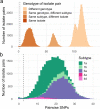Incidence and molecular epidemiology of hepatitis C virus reinfection in prisons in Catalonia, Spain (Re-HCV study)
- PMID: 37749145
- PMCID: PMC10520040
- DOI: 10.1038/s41598-023-42701-1
Incidence and molecular epidemiology of hepatitis C virus reinfection in prisons in Catalonia, Spain (Re-HCV study)
Erratum in
-
Author Correction: Incidence and molecular epidemiology of hepatitis C virus reinfection in prisons in Catalonia, Spain (Re-HCV study).Sci Rep. 2023 Oct 12;13(1):17287. doi: 10.1038/s41598-023-44581-x. Sci Rep. 2023. PMID: 37828072 Free PMC article. No abstract available.
Abstract
Hepatitis C virus (HCV) reinfection may hamper HCV elimination in prisons. We aimed to (i) determine the reinfection rate in people treated for HCV in Catalan prisons, (ii) measure reinfection in people entering prisons, and (iii) characterize the molecular epidemiology of HCV in prisons and people who inject drugs (PWID) in the community. Re-HCV was a prospective study in eight prisons (2019-2020) including two groups: (1) people cured with treatment in prison and followed-up every 6 months, and (2) people testing HCV-RNA positive at incarceration. Bio-behavioral data were collected. HCV isolates were sequenced and phylogenetically analyzed with those of PWID in the community. Reinfection follow-up after treatment was achieved in 97 individuals (103.05 person-years). Two reinfections were detected, resulting in an incidence ≤ 10/100 person-years. Among people entering prison, 2% (359/17,732) were viremic, of which 334 (93.0%) were included, and 44 (13.5%) presented with reinfection (84.7% being PWID). Frequently, HCV isolates in prisons and PWID in the community were phylogenetically related. Although HCV reinfection is low after treatment, it is common in people entering Catalan prisons. To maintain a low HCV prevalence in prisons, harm-reduction services and test-and-treat programs for PWID should be strengthened both inside and outside prisons.
© 2023. Springer Nature Limited.
Conflict of interest statement
Regarding competing interests, VS received travel sponsorship to attend scientific meetings from Gilead Sciences and Cepheid; AM presented lectures at Symposia or Conferences organized by Gilead, Janssen, MSD, Abbvie, and ViiV, as well as consulting services for MSD and Camurus; and EM received lecture fees and research grants from Abbott GmbH & Co. K. G, Gilead Sciences, Cepheid, and Abbvie. The other authors declare no competing interests.
Figures



Similar articles
-
Reinfection in a large cohort of prison inmates with sustained virological response after treatment of chronic hepatitis C in Catalonia (Spain), 2002-2016.Int J Drug Policy. 2019 Oct;72:189-194. doi: 10.1016/j.drugpo.2019.05.014. Epub 2019 May 31. Int J Drug Policy. 2019. PMID: 31160156
-
Modelling the impact of incarceration and prison-based hepatitis C virus (HCV) treatment on HCV transmission among people who inject drugs in Scotland.Addiction. 2017 Jul;112(7):1302-1314. doi: 10.1111/add.13783. Epub 2017 Mar 3. Addiction. 2017. PMID: 28257600 Free PMC article.
-
Hepatitis C virus reinfection after successful treatment with direct-acting antiviral therapy in a large population-based cohort.J Hepatol. 2018 Nov;69(5):1007-1014. doi: 10.1016/j.jhep.2018.07.025. Epub 2018 Aug 22. J Hepatol. 2018. PMID: 30142429
-
Hepatitis C Reinfection in People Who Inject Drugs in Resource-Limited Countries: A Systematic Review and Analysis.Int J Environ Res Public Health. 2020 Jul 9;17(14):4951. doi: 10.3390/ijerph17144951. Int J Environ Res Public Health. 2020. PMID: 32659974 Free PMC article.
-
Risk of hepatitis C reinfection following successful therapy among people living with HIV: a global systematic review, meta-analysis, and meta-regression.Lancet HIV. 2022 Jun;9(6):e414-e427. doi: 10.1016/S2352-3018(22)00077-7. Lancet HIV. 2022. PMID: 35659336
Cited by
-
The COVID-19 Pandemic Affected Hepatitis C Virus Circulation and Genotypic Frequencies-Implications for Hepatitis C Prevention, Treatment and Research.Epidemiologia (Basel). 2024 Apr 4;5(2):160-166. doi: 10.3390/epidemiologia5020011. Epidemiologia (Basel). 2024. PMID: 38651388 Free PMC article.
-
Hepatitis C Virus-Pediatric and Adult Perspectives in the Current Decade.Pathogens. 2024 Dec 29;14(1):11. doi: 10.3390/pathogens14010011. Pathogens. 2024. PMID: 39860972 Free PMC article. Review.
-
Point-of-Care Testing and Treatment of Hepatitis C Virus in Prisons: The SINTESI Project in Sicily.Mayo Clin Proc Innov Qual Outcomes. 2025 Jul 19;9(4):100643. doi: 10.1016/j.mayocpiqo.2025.100643. eCollection 2025 Aug. Mayo Clin Proc Innov Qual Outcomes. 2025. PMID: 40727610 Free PMC article.
-
How to eliminate hepatitis C between people who inject drugs in community services and prisons in Catalonia.Harm Reduct J. 2025 Jul 31;22(1):133. doi: 10.1186/s12954-025-01286-w. Harm Reduct J. 2025. PMID: 40745598 Free PMC article. Review.
References
-
- World Health Organization. Interim guidance for country validation of viral hepatitis elimination. Geneva: World Health Organization. https://www.who.int/publications-detail-redirect/9789240028395 (2021).
-
- Generalitat de Catalunya. Departament de Salut. Plà de prevenció i control de l’hepatitis C a Catalunya. http://salutpublica.gencat.cat/web/.content/minisite/aspcat/vigilancia_s... (2018).
-
- Ministerio de Sanidad Servicios Sociales e Igualdad. Strategic Plan for Tackling Hepatitis C in the Spanish National Health System 2015. https://www.mscbs.gob.es/ciudadanos/enfLesiones/enfTransmisibles/hepatit... (2015).
-
- Marco, A., Guerrero, R. A. & Turu, E. Control of HCV infection in prisons in Catalonia, Spain. Compendium of good practices in the health sector response to viral hepatitis in the WHO European Region. Copenhagen: WHO Regional Office for Europe (2020).
Publication types
MeSH terms
LinkOut - more resources
Full Text Sources
Medical

